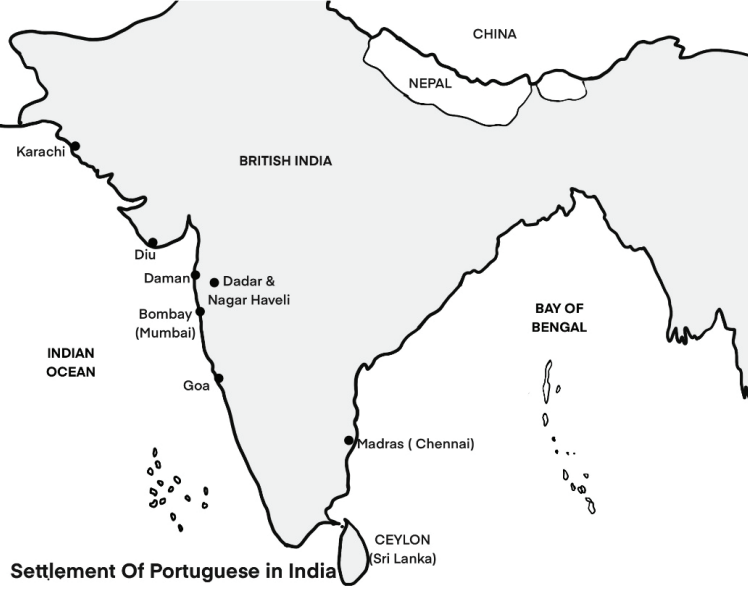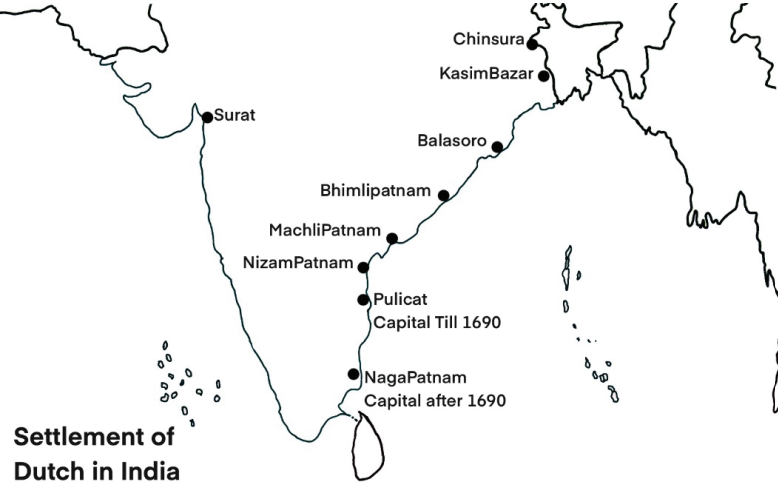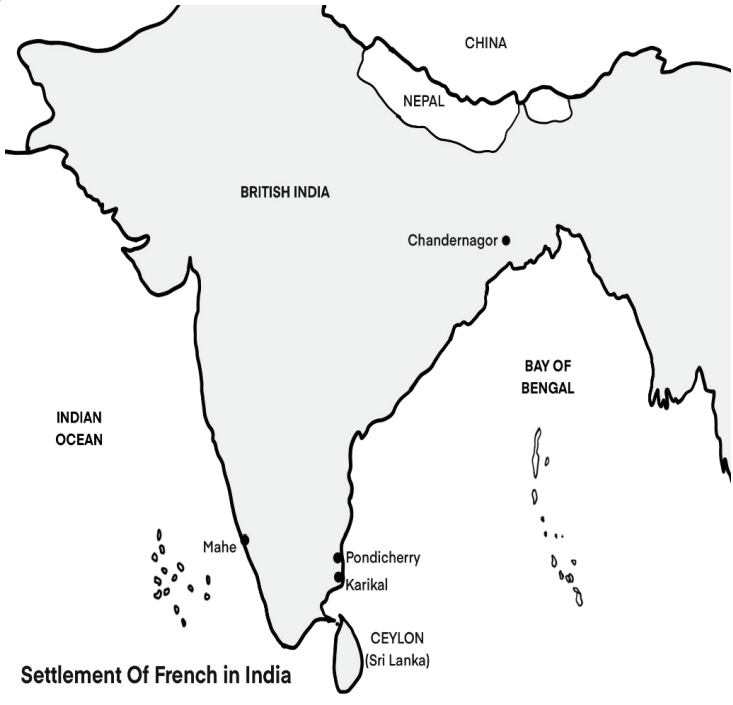Modern History Playlist
19 chapters • 0 completed
Advent of Europeans in India
9 topics
Decline of the Mughal Empire
7 topics
Emergence of Regional States
11 topics
Expansion and Consolidation of British Power
19 topics
British Government & Economic Policies (1757–1857)
4 topics
Social Reform Movements
20 topics
People’s Resistance before 1857
3 topics
The revolt of 1857
6 topics
Growth of Nationalism and Moderate Phase of Congress
6 topics
British Administration in India
7 topics
Era of Militant Nationalism (1905-1909)
5 topics
First Phase of Revolutionary Activities(1907-1917)
8 topics
India’s Response to First World War and Home Rule Movement
4 topics
Emergence of Gandhi
6 topics
Non-Cooperation Movement and Khilafat Movement
7 topics
Emergence of Swarajists, Socialist Ideas, Revolutionary Activities
5 topics
Struggle For Swaraj: 1928-1935
13 topics
Period from 1935-42
9 topics
Period from 1942-47
22 topics
Chapter 1: Advent of Europeans in India
Chapter TestBackground & Early Contacts
Fall of Constantinople (1453) to the Ottoman Turks pushed European powers, especially Portugal and Spain, to seek direct sea routes to India, bypassing the controlled land routes.
Fall of Constantinople (1453) to the Ottoman Turks pushed European powers, especially Portugal and Spain, to seek direct sea routes to India, bypassing the controlled land routes.
Why Europeans Sought Sea Routes to India
| Reason | Explanation |
|---|---|
| Blocked Overland Routes | Fall of Constantinople (1453) by Ottoman Turks disrupted traditional land trade with Asia. |
| Economic Gain (Mercantilism) | To get direct access to spices (pepper, cloves) and luxury goods, bypassing Arab/Venetian intermediaries for higher profits. |
| Technological Capability | New ship designs (Caravel) and navigation tools (Compass, Astrolabe) made long oceanic voyages feasible. |
| Religious & Political ('God & Glory') | Missionary zeal to spread Christianity and national rivalry/prestige for monarchs. |
Fun Facts
‘Age of Discovery’ (approx. 15th–17th centuries) was funded by monarchs and new joint-stock companies.
Prince Henry the Navigator of Portugal sponsored many expeditions down the African coast, running a school for navigation, though he never sailed himself.
Mains Key Points
Prelims Strategy Tips
Portuguese in India
Vasco da Gama reached Calicut in 1498, opening the sea route. Key figures were Francisco de Almeida (Blue Water Policy) and Alfonso de Albuquerque, who captured Goa (1510) from the Sultan of Bijapur, establishing the first European territorial base in India.
Vasco da Gama reached Calicut in 1498, opening the sea route. Key figures were Francisco de Almeida (Blue Water Policy) and Alfonso de Albuquerque, who captured Goa (1510) from the Sultan of Bijapur, establishing the first European territorial base in India.

Portuguese Features in India
| Feature | Explanation (Keywords for Beginners) |
|---|---|
| 'Blue Water Policy' | Naval supremacy. Control the *sea*, not the *land*. (Championed by Almeida). |
| Cartaz (Pass) System | A naval trade license or pass. Ships without it were seized. (Essentially a protection racket to enforce monopoly). |
| Territorial Conquest | Capture of key ports like Goa, Diu, Daman, Cochin. (Championed by Albuquerque). |
| Missionary Activity | Strong religious focus, including forced conversions and the Goa Inquisition. |
Portuguese Contributions to India
| Area | Contributions | Notes for UPSC |
|---|---|---|
| Agriculture (Crops) | Brought new crops from the Americas: Potato, Tomato, Chillies, Pineapple, Cashew, Tobacco. | Transformed Indian cuisine and agriculture. This is a very common prelims topic. |
| Culture & Architecture | Introduced Gothic architecture in India (e.g., churches in Goa). | Cultural fusion in Goa (music, dance, cuisine). |
| Technology/Printing | Introduced the first printing press in India (at Goa in 1556). | Mainly for religious texts (Bibles, catechisms). |
| Maritime/Military | Improved shipbuilding techniques; introduction of the 'galleon' design. | Pioneered the 'Cartaz-Armada' system of naval control, later adopted by others. |
Fun Facts
Goa remained under Portuguese control from 1510 until 1961 (Operation Vijay), long after the rest of India gained independence in 1947.
The Portuguese were the first Europeans to arrive in India (1498) and the last to leave (1961).
Mains Key Points
Prelims Strategy Tips
Dutch in India
The VOC (Dutch East India Company, 1602) was a massive corporation focused on the spice trade. Their main interest was the Spice Islands (Indonesia), not India. They were decisively defeated by the British at the Battle of Bedara (1759), ending their ambitions in India.
The VOC (Dutch East India Company, 1602) was a massive corporation focused on the spice trade. Their main interest was the Spice Islands (Indonesia), not India. They were decisively defeated by the British at the Battle of Bedara (1759), ending their ambitions in India.

Dutch Presence — Key Points
| Aspect | Note (Why it matters) |
|---|---|
| Main Interest | Spice Islands (Indonesia). India was a source for textiles to *trade* for spices. |
| Key Settlements | Pulicat (HQ), Masulipatnam, Chinsurah (Bengal). |
| Key Defeat (by Indians) | Battle of Colachel (1741): Defeated by Marthanda Varma of Travancore. |
| Key Defeat (by British) | Battle of Bedara (1759): Decisively beaten by the British; ended their Indian ambitions. |
Portuguese Contributions to India
| Area | Contributions | Notes |
|---|---|---|
| Culinary | Chillies, cashew, tomato, pineapple, guava | Transformed regional cuisines; vindaloo originated from Portuguese 'vinha d'alhos' |
| Cultural/Religious | Expansion of Christian (Catholic) communities, loanwords in local languages | Goan Konkani Catholic culture notable |
| Education/Printing | Missionary schools, early printing presses | Spread of Western-style education in coastal enclaves |
| Navigation/Maps | Pilots' guides & charts, cartography | Improved European knowledge of Indian Ocean routes |
Fun Facts
The VOC (Dutch EIC) is considered the first company to issue public stock, making it a pioneer of modern corporate finance.
After their defeat at Bedara, the Dutch and British agreed to a swap: the British gave up their claims in Indonesia in exchange for the Dutch giving up their claims in India.
Mains Key Points
Prelims Strategy Tips
British in India
The English East India Company (EIC), chartered in 1600, transformed from a trading body into a territorial power. Key events were the 1717 Farman, the Battle of Plassey (1757), and the Battle of Buxar (1764), which led to the Diwani of Bengal (1765).
The English East India Company (EIC), chartered in 1600, transformed from a trading body into a territorial power. Key events were the 1717 Farman, the Battle of Plassey (1757), and the Battle of Buxar (1764), which led to the Diwani of Bengal (1765).
Phases in British Expansion
| Phase | Features & Key Events |
|---|---|
| Trading Phase (1600–1757) | Factories (Surat, Madras), Diplomacy (Roe), 1717 Farman. Focus was on commerce. |
| Political Consolidation (1757–1765) | Battle of Plassey (1757): Political control. Battle of Buxar (1764): Military dominance. |
| Start of 'Company Rule' (Post-1765) | Treaty of Allahabad (1765): Acquired Diwani rights. Start of 'Dual System' in Bengal. Shift from trader to ruler. |
Fun Facts
The EIC was a private company that came to rule an entire subcontinent. It had its own private army, which was larger than the official British Army at its peak.
Bombay (Mumbai) came to the British King Charles II as a dowry when he married Catherine of Braganza from Portugal. He rented it to the EIC for just £10 of gold per year.
Mains Key Points
Prelims Strategy Tips
French in India
The French East India Company (1664) was the last to arrive. Their ambitions, led by Governor Dupleix, led to the Carnatic Wars with the British. The decisive French defeat at the Battle of Wandiwash (1760) ended their hopes of an Indian empire.
The French East India Company (1664) was the last to arrive. Their ambitions, led by Governor Dupleix, led to the Carnatic Wars with the British. The decisive French defeat at the Battle of Wandiwash (1760) ended their hopes of an Indian empire.

French Strategy & Outcome
| Aspect | Note (Why it matters for UPSC) |
|---|---|
| Company Structure | State-controlled. This made it less flexible and commercially driven than the private British EIC. |
| Key Leader | Dupleix. Pioneered interfering in local politics (Subsidiary Alliance concept). |
| Decisive Battle | Battle of Wandiwash (1760). British victory ended French political ambitions. |
| Final Treaty | Treaty of Paris (1763). Allowed French to keep posts but *without fortification*. |
Fun Facts
Pondicherry (Puducherry) still reflects its French cultural, architectural, and linguistic legacy. It only became part of India in 1954.
The strategies Dupleix used (like the subsidiary alliance) were failures for the French but were copied and perfected by the British (notably by Lord Wellesley) to build their own empire.
Mains Key Points
Prelims Strategy Tips
Danish & Other Minor Europeans
The Danish presence was small, focused on trade and missionary work. Their key settlements were Tranquebar (Tamil Nadu) and Serampore (Bengal). Serampore became a major center for printing and education.
The Danish presence was small, focused on trade and missionary work. Their key settlements were Tranquebar (Tamil Nadu) and Serampore (Bengal). Serampore became a major center for printing and education.
Fun Facts
Serampore College, founded by the Danes, was the first institution in Asia to be granted the status of a university (by a Danish Royal Charter).
Mains Key Points
Prelims Strategy Tips
Anglo-French Rivalry & Carnatic Wars
A series of three wars (1740s-1763) in South India (the Carnatic region) between the British and the French, who supported rival local claimants. The British victory in the Third Carnatic War (Battle of Wandiwash, 1760) established their supremacy.
A series of three wars (1740s-1763) in South India (the Carnatic region) between the British and the French, who supported rival local claimants. The British victory in the Third Carnatic War (Battle of Wandiwash, 1760) established their supremacy.
Carnatic Wars — Quick Snapshot
| War | Dates | European Link | Result in India |
|---|---|---|---|
| First Carnatic War | 1746–1748 | War of Austrian Succession | Inconclusive. Ended by Treaty of Aix-la-Chapelle. Madras restored to British. |
| Second Carnatic War | 1749–1754 | None (Local disputes). | Inconclusive, but British gained influence. Dupleix recalled. |
| Third Carnatic War | 1757–1763 | Seven Years' War | Decisive British Victory. Battle of Wandiwash (1760). Treaty of Paris (1763) ended French ambitions. |
Treaties Ending the Carnatic Wars
| Treaty | Year | Effect on India |
|---|---|---|
| Treaty of Aix-la-Chapelle | 1748 | Ended First Carnatic War; restored captured territories (status quo ante) |
| Convention/Treaty of Pondicherry | 1754 | Ended Second Carnatic War; created fragile local settlement pending European developments |
| Treaty of Paris | 1763 | Ended Third Carnatic War and Seven Years' War; confirmed British supremacy in India while permitting French trading posts without political interference |
Fun Facts
The Carnatic Wars were where Robert Clive first made his name as a brilliant (and lucky) military strategist with the Siege of Arcot, long before the Battle of Plassey.
The Seven Years' War (of which the 3rd Carnatic War was a part) is often called the first *true* world war, as it was fought in Europe, North America, and Asia (India).
Mains Key Points
Prelims Strategy Tips
Economic, Social & Cultural Impact
European arrival led to the rise of new port cities (Presidency Towns), the introduction of new crops, and the 'Commercialization of Agriculture'. Post-1765, it led to the 'Drain of Wealth' and the decline of traditional artisans (Deindustrialisation).
European arrival led to the rise of new port cities (Presidency Towns), the introduction of new crops, and the 'Commercialization of Agriculture'. Post-1765, it led to the 'Drain of Wealth' and the decline of traditional artisans (Deindustrialisation).
Key Economic Effects — A Summary
| Concept | Explanation (What it means for beginners) |
|---|---|
| Rise of Port Cities | Bombay, Madras, Calcutta replaced older ports like Surat as new economic centers. |
| Commercialization | Forcing peasants to grow cash crops (indigo, opium) for export, not food for themselves. |
| Deindustrialisation | Decline of Indian weavers/artisans due to competition from British machine-made goods. |
| Drain of Wealth | (Post-1765) Using Indian tax money (revenue) to buy Indian goods for export. No benefit to India. |
Fun Facts
The term 'loot' entered the English language from the Hindi word 'लूट' during this period, describing the plunder of Bengal by EIC officials after 1757.
Mains Key Points
Prelims Strategy Tips
Major Battles & Turning Points
A few key battles decided the fate of European powers: Diu (1509) established Portuguese naval power, Colachel (1741) showed Indian resistance to the Dutch, Plassey (1757) gave the EIC political control, Buxar (1764) gave it legal authority (Diwani), and Wandiwash (1760) eliminated the French.
A few key battles decided the fate of European powers: Diu (1509) established Portuguese naval power, Colachel (1741) showed Indian resistance to the Dutch, Plassey (1757) gave the EIC political control, Buxar (1764) gave it legal authority (Diwani), and Wandiwash (1760) eliminated the French.
Key Battles and Their Significance
| Battle | Year | Who Fought (Winner in Bold) | Significance (What it decided) |
|---|---|---|---|
| Battle of Diu | 1509 | Portuguese vs. Gujarat/Egypt Fleet | Established Portuguese naval supremacy in Indian Ocean. |
| Battle of Colachel | 1741 | Travancore vs. Dutch (VOC) | Showed that Indian states could defeat Europeans; ended Dutch hopes in Malabar. |
| Battle of Plassey | 1757 | British EIC vs. Nawab of Bengal | Gave EIC political control of Bengal (through conspiracy). |
| Battle of Wandiwash | 1760 | British EIC vs. French EIC | Decisively ended all French political ambitions in India. |
| Battle of Buxar | 1764 | British EIC vs. Combined Indian Armies | Gave EIC legal/revenue control (Diwani) of Bengal (through military victory). |
Fun Facts
The Battle of Plassey was won with minimal British casualties because the main Indian forces, under the traitor Mir Jafar, refused to fight.
The Battle of Buxar is considered far more significant by historians than Plassey, as it was a 'fair fight' that the EIC won against the Mughal Emperor himself, giving them true legitimacy.
Mains Key Points
Prelims Strategy Tips
Chapter Complete!
Ready to move to the next chapter?
